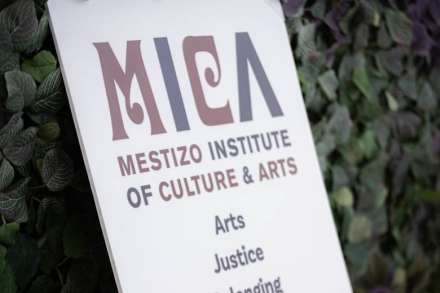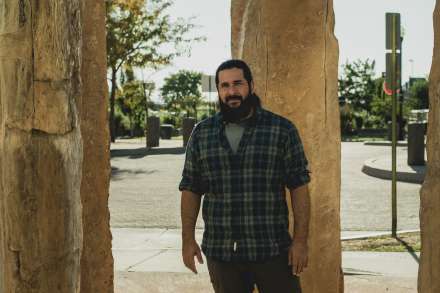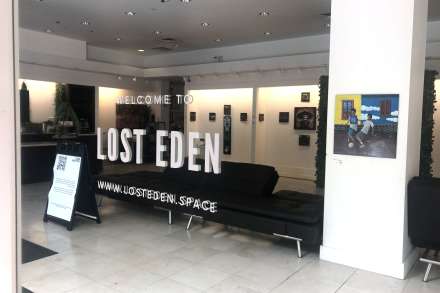While there have been many stereotypes about our salty city, there is much more than meets the eye in SLC. Salt Lake’s West Side communities tend toward more racial and economic diversity, a fact that Salt Lake’s Mestizo Institute of Culture and Arts—a local grassroots organization working to strengthen and empower West Side communities through art—is bringing to light. According to them, the word ‘mestizo’ should be one of the first to mind when thinking of our city’s identity.

How MICA Was Founded
Mestizo is a Spanish term that historically refers to the blending of Spanish and Indigenous cultures, but for those at Mestizo Institute of Culture and Arts (MICA), it is a word that has come to hold a broader meaning: the overall blending of cultures. Founded by Ruby Chacón, a Utah native and Chicana muralist whose work is on display in murals around Salt Lake City (including the Cihuacoatl and Golden Rule murals in the Marmalade district), and activist and artist Terry Hurst, MICA seeks to amplify the voices that are less known. Salt Lake is often perceived as having less diversity than other US cities, but there is plenty of cultural representation happening in our little valley, be it Latinx, Pacific Islander, LGBTQ+, refugees and many more.
Elevating Community Voices
Members of these groups have often been provided with less access to quality education, especially in the arts. Out of the necessity to protect these local, underrepresented communities, MICA was founded in 2003 as a grassroots organization with the goal of elevating the artistic voices in these communities, hoping “to tell their own stories through art.” Drawing on the mestizo identity, this group explains how they highlight art “that celebrates and honors our indigeneity and our ancestors, but also acknowledges the historical traumas that stem from colonization.”
Arts, Justice, Belonging, and Community Power
Members of the MICA’s board, along with its founders, identified four areas the group would focus its efforts upon to encourage communities: arts, justice, belonging, and community power. With these in mind, MICA has organized a variety of programs and community events over the organization’s last 19 years. Horacio Rodriguez, acting Board Chair and Curator of MICA, explains some of the ways they have supported artists. “We offer up-and-coming artists a chance to show their work in a professional gallery as well as support them in creating artists' statements, photographing their work and making important community connections.” This support includes performing artists in addition to traditional physical artists.

Supporting Minority Utah Artists
“I think it's awesome that [MICA] is looking for artists that are minorities … helping them with every single aspect of putting together a show,” shares Nestor Jimenez, one of the artists MICA most recently collaborated with. According to Jimenez, the team at MICA keeps a close eye on the local art community, following their work and reaching out with encouragement and support. “To have someone reach out and say ‘Hey, I've been following you, I like your art and I would like to help you learn how to promote your work and how to start a career if that’s what you want … without charging me anything, I think that is great,” says Jimenez. In the past MICA has worked with a range of Utah artists, including Ali Mitchell, Andrew Alba, Kathy Tran, and Mikel Lawlor.

Youth Art Programs
Along with artist events, youth programs are a large part of MICA’s outreach, with a focus on west side youth of color and youth of immigrant and refugee backgrounds, who often lack consistent access to arts education opportunities. The Hartland Arts Residency is one MICA initiative that supports local artists and K–12 students alike. Utah artists are invited to work with students on creating art within their specialty. Past work has included ceramics, public muralism, and painting. Providing a safe place for artistic expression for these kids is at the core of MICA’s mission—to amplify their voices and to bring more beauty into the world around us.
Pain and Possibility: A Community Art Series
One of MICA’s more recent projects was organized in August of 2020, titled Pain and Possibility. This community art series prompted local artists to respond to the challenging cultural moment marked by quarantine and political unrest. With the phrase “wrestling with today and reimagining tomorrow” in mind, 19 artists representing BIPOC, LGBTQ+, and allies participated, creating 26 performances across 10 locations. Works ranged from mural painting, sculpture, dance, video, and other media, and MICA worked with filmmaker Joshua N. Samson to create a short film about the work, the artists, and their stories. You can check out the Pain and Possibility project on MICA’s website, with videos and photos of each art installation.

MICA's Current Gallery Show with Nestor Jimenez
MICA’s current gallery exhibition is at Lost Eden in The Gateway. It features the work of local artist Nestor Jimenez. Titled “Ingenuo/Naive,” this collection toys with the idea of being without experience. He explains, “I consider myself a naive artist. I have no training, I'm not looking for perfection when it comes to technique, I’m just looking to connect with people through the paintings.” The title also offers a play on words, nodding at the tradition of naive art, which resists conformity to sophisticated techniques, instead finding expression through bright, child-like colors, and bold directness. Here, he finds more freedom: “When you call yourself naive, you are allowed to make many mistakes, all the mistakes you want, and keep growing because you’re never going to be perfect,” says Jimenez. Find more of the artist’s work on Instagram @artbynestorjimenez.

Check Out Local BIPOC Artists and Support the Mestizo Institute of Cultural Arts
For those looking to get connected with MICA, Rodrigez says not to hesitate! “Underrepresented and BIPOC artists are always encouraged to reach out to MICA if they need support financially or otherwise; we are here to help the arts community,” he says.
The best way to support MICA is by attending their events. Go see Nestor Jimenez’ "Ingenuo/Naive" art exhibit at Lost Eden (71 South Rio Grande Street in The Gateway) through September 30. You can continue to stay in the know by following MICA on Instagram @mestizoarts_slc or checking their website mestizoarts.org